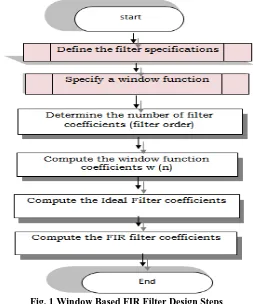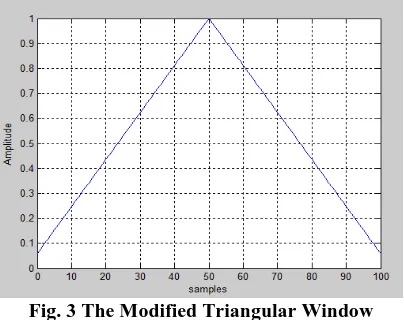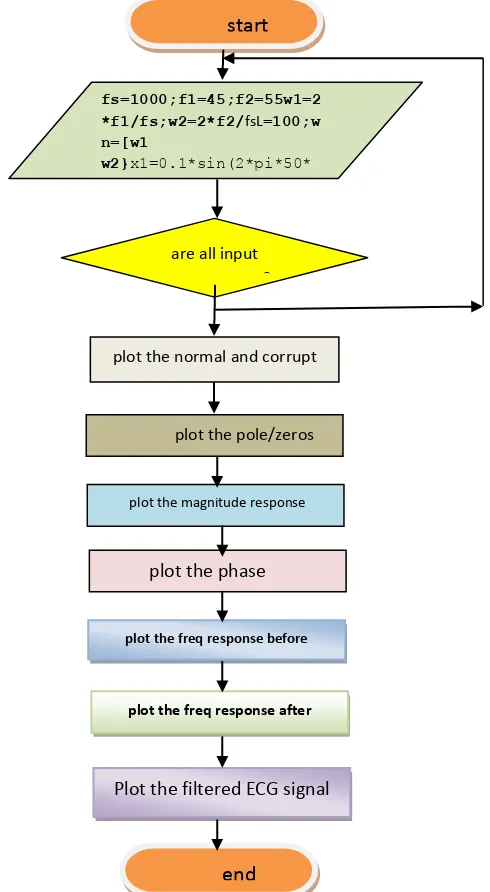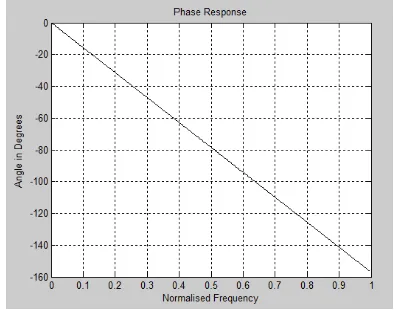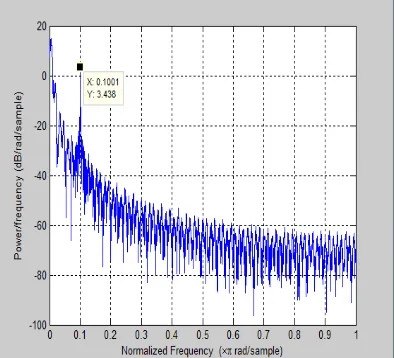Vol. 05, Issue 06 (June. 2015), ||V1|| PP 32-38
Enhancing Ecg Signals Using Triangular Window Based Fir
Digital Filtering Technique
Idigo F., Alor M.O., and Onoh G.N.,
Electrical and Electronics Engineering Department, Enugu State University of Science & Technology, Enugu, Enugu State, Nigeria.
Abstract: - Electrocardiography generates signals referred to as Electrocardiographic signals or simply ECG which describes the electrical activities of the heart and is very vital in the clinical monitoring and diagnosis of the health conditions of the human heart. Naturally during acquisition, the ECG signals get distorted by different artifacts such as Baseline Wander, Muscle Contractions, Equipment Artifact, Powerline Interference etc., which must be removed otherwise incorrect information regarding the patient’s heart condition will be conveyed. However, the most significant signal that corrupt the ECG is Powerline Interference. Hence, for correct extraction of the features of the ECG signal there is need to separate the wanted signal from noise caused by these signals that corrupt the ECG. Different types of digital filters can be used to achieve this. In this work, a Modified Triangular Window FIR filter was used for the removal of the 50Hz Powerline interference in the ECG. Using MATLAB The Signal Power before and after filtration using the modified window was determined and compared with that of triangular window and simulation results obtained.
Keywords: ECG Signals, Biomedical, Powerline interference, FIR filter, Triangular Window
I.
INTRODUCTION
Electrocardiographic signals describe the electrical activity of the heart, and are universally employed in the diagnosis of cardiac pathologies.The ECG signal frequency ranges from 0.5Hz to 100Hz, and during acquisition, various artifacts contaminate the Electrocardiogram (ECG) recording, such as;
1. Power line interference 2. Electrode contact noise 3. Motion artifacts 4. Muscle contraction 5. Base line drift
When doctors use electrocardiography they can identify dangerous heart conditions, such as heartbeats that are not rhythmic, and treat the conditions appropriately [1]. However, if these conditions are not diagnosed early the individuals will mature into adulthood only to suffer sudden cardiac death as their first visible symptom [2]. For the meaningful and accurate detection, steps have to be taken to filter out or discard all these noise sources. Many tools, methods and algorithms from signal processing theory have been proposed, described and implemented [3]. Different window functions are used in Digital Signal Processing (DSP) for Finite Impulse Response (FIR) filter design.
In [4] Bhattacharya simulated the frequency responses of the four basic types of Finite Impulse Response (FIR) filters using a modified Taylor window function. Then he compared the
removing powerline interference and, good enough for correct clinical interpretations. Also Mbachu in [9] examined the effectiveness of six different types of window functions including the Height Adjustable Triangular (HAT) Window with the value of alpha as 0.02 in the design and development of digital FIR notch filters for reduction of powerline interference in ECG. From results, the Kaiser window was relatively most effective in reducing the 50Hz powerline interference.
II.
THE WINDOW CONCEPT
The design of Digital Filters using window method involves obtaining the Desired Impulse Response or Unit Sample Response from the Desired Frequency Response of the filter.
Naturally the Impulse Response of the filter is of infinite duration which implies that the filter resulting
from the Fourier series representation without application of any weighting factor on the series is
unrealizable. To make the series finite and hence realizable (i.e having a Finite Impulse Response) the Fourier Series is truncated at point n = M for instance where M is a whole number representing the length of the unit sample response desired). This direct truncation of the series will actually make the filter finite but will lead to Gibbs Phenomenon which manifests itself as a fixed percentage overshoot and ripple before and after approximated discontinuities in the frequency response. A better approach is to use a finite weighting sequence called window, w(n), to modify the Fourier coefficients in (1) i.e multiplying by a window sequence . where represents generalized window function. With Window application, the Unit
Sample or Impulse Response of the FIR filter is then given as; = …. (3)
can also be called the designed FIR filter coefficients.
III.
TRIANGULAR WINDOW BASED DIGITAL FILTERING TECHNIQUE
The design of FIR filter using windows follows a sequence as depicted by fig. 1
In defining the filter specification the sampling frequency (fs) is taken to be 1000Hz and the cut off frequencies
(fc1 and fc2) are 45Hz and 55Hz respectively, and the filter order is taken to be 100.
The Triangular window function for total number of samples, M = 100 plotted with Matlab is shown in fig. 2 and is described by the expression 2.4. The sample points (n) are indicated along x-axis and the corresponding amplitude levels along y-axis respectively.
Fig. 2 The Triangular Window
The Triangular window based FIR digital filter is therefore a filter obtained from the modification of the Triangular window function and is given as:
…… (5)
To modify the triangular window, the amplitude in fig. 2 ie W(n) is pulled up to alpha ( ) at the rising and falling sides of the triangle, where alpha varies from 0 to 1. In this work, alpha is taken to be 0.06.
With the modified Triangular window function given in equation (5) and input signals defined as x1 = 0.1*sin (2*pi*50*(k-1)/fs) …. (6)
x = 3.5*ecg (3000) …… (7)
the impulse response of the FIR filter is improved and better results obtained.
Fig. 3 The Modified Triangular Window
The Desired Unit Sample or Impulse Response for bandstop FIR filter also called the Desired Filter coefficients is given as;
The steps for modeling of the modified system are described in the flowchart as shown in fig. 4.
Fig. 4 Flowchart of the Procedures for Modeling the Modified System
IV.
RESULTS
A corrupt ECG signal generated by Matlab is shown in fig. 5, obtained by superimposing a 50hz noise source equation (7) on a clean ECG signal equation (6). The corrupt signal is then passed through the modified window FIR filter, and other results obtained.
plot the phase response
Plot the filtered ECG signal plot the freq response after
filtration
fs=1000;f1=45;f2=55w1=2 *f1/fs;w2=2*f2/fsL=100;w n=[w1
w2}x1=0.1*sin(2*pi*50*
k-1)/fs); x=3.5*ecg(3000)
are all input arguments set?
start
No
yes
plot the normal and corrupt ECG
plot the pole/zeros
plot the magnitude response
plot the freq response before filtration
Fig. 6 Pole/Zero Plot of the FIR Filter
The poles and Zeros and are equivalent ways of describing the coefficients of a linear system and they have a direct influence on the dynamic properties of the system. The pole-zero plot depicted in fig. 6 shows that there is symmetry in pole-zero across the imaginary axis and that the system is stable.
Fig. 7 Magnitude Response of the FIR Filter
The magnitude response depicted in fig. 7 shows closeness to the ideal situation.
Fig. 8 Unwrapped Phase Response of the FIR Filter
straight line in one or two or more segments of the line. The Lack of phase/delay distortion as with the case of linear filters, can be a critical advantage of FIR filters.
Fig. 9 Frequency Response (before filtration) of the FIR Filter
Fig. 10 Frequency Response (after filtration) of the FIR Filter
V.
SUMMARY AND CONCLUSION
The removal or filtering of noise in ECG signal has remained a classical problem and more worrisome is the fact that Powerline interference is a constituent part of the ECG waveform. From results, the magnitude response of fig 7 indicates that the filter is very stable, and therefore the coefficients of the filter cannot upset the filter stability. A condition of steady state output is therefore guaranteed. The phase response of fig 8 shows that the filter is of linear phase which is desirable in processing complex signals like ECG signals. This ensures that multiple frequency signals do not suffer differential phase shifts, and as well the filter does not make the required intelligent signal tow a wrong position which leads to erroneous clinical diagnosis of the patient. From fig. 9, the power of the ECG signal corrupt with 50Hz powerline interference before filtration is (3.438dB) and from fig. 10, the power of the corrupt ECG signal at 50hz after filtration is (-10.53dB). This implies that the fitter removes the Powerline Interference in the noisy ECG signal. The conclusion from the results therefore is that Power Line Interference has been successfully and efficiently removed by the Modified Triangular Window Based FIR filter.
REFERENCES
[1] Heart and Circulatory, Tachycardia, Harvard Medical School for InteliHealth, Source on the Internet: Aetna Inteli Health, Available at: http://www.intelihealth.com
[2] Understanding the Heart's Electrical Messages, Source on the internet: Essential EKG (ECG) Information For Physicians, January, 2006, Available at: http://themdsite.com
[4] Ankan Bhattacharya; “A window function for FIR filter design with an improved frequency response and
its comparison with the Taylor window”; ISSN: 2278 – 7798; International Journal of Science, Engineering and Technology Research (IJSETR); Volume 2, Issue 5, August 2013.
[5] P.V.Muralidhar, K.krishnamraju, S.K.Nayak and P.V.S.Nirosha Devi “ECG signal with hybrid window technique”; ISSN: 2278 – 7798; International Journal of Science, Engineering and Technology Research (IJSETR); Volume 1, Issue 4, October 2012.
[6] Suhaib Ahmed; “Design Analysis of High Pass FIR Filters Using Hanning, Bartlett and Kaiser Windows
” ; ISSN: 2277 128X; International Journal of Advanced Research in Computer Science and Software Engineering (IJARCSSE); Volume 2, Issue 11, November 2012.
[7] Suman E. U. ; “Optimized Noise Canceller for ECG Signals” International Conference on Intelligent Systems and Data Processing (ICISD) 2011. Special Issue published by International Journal of Computer Applications (IJCA)
[8] Mbachu C.B. and Offor Kennedy; “Evaluation of the Effectiveness of Triangular Window-Based FIR
Digital Filter For Enhancement of ECG signal” ISSN 2278-3687 International Journal of Science, Environment and Technology, Vol. 2, No 6, 2013, 1327 – 1334
[9] Mbachu C.B; “Performance Analysis of Various Windows in The Reduction of Powerline Interference In
